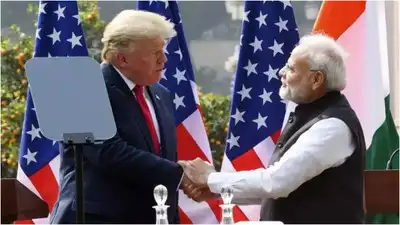India-US Trade Deal: Boosting Economic Ties

US President Donald Trump and Prime Minister Narendra Modi (File Image)
NEW DELHI: Trade talks between India and the US are moving forward. President Donald Trump hinted at a “very big” agreement with India soon. At a White House press conference, Trump said, “Everybody wants to make a deal. We just signed with China yesterday. We have great deals coming up, maybe with India. A very big one. We’re going to open up India. In the China deal, we are starting to open up China.”
Trump added, “We’re not going to make deals with everybody. Some we are just going to send them a letter, say thank you very much. You are to pay 25, 35, 45 percent. That’s the easy way to do it, but my people don’t want to do it that way. They want to make more deals than I would do.”
How It Affects Agriculture, Tariffs, and Energy
The trade relationship between India and the United States is set to change significantly. This could lower tariffs, making US products more competitive in India, especially in energy, agriculture, defense, and aviation sectors.
Key Points of the Trade Deal
- Tariffs: India has higher average tariffs compared to the US. The new trade agreement could benefit American exporters.
- Recent Changes: The US implemented a 26% reciprocal tariff on Indian products in April 2025 but suspended it for 90 days from April 10, maintaining a 10% basic duty.
- Progress: Bilateral discussions have sped up, showing substantial progress in digital trade, market access, customs procedures, and technical standards.
- Trade Volume: India-US trade reached $131.84 billion in FY25, making India the US’s primary trading partner.
Impact on Different Sectors
- Energy: India’s growing energy needs, especially for LNG, could create beneficial partnerships with US suppliers. LNG offers price stability and suitability for long-term contracts over crude oil.
- Agriculture: Imports of US agricultural products like walnuts, pistachios, and cranberries might increase, although broader access remains disputed.
- Defense: The defense sector presents significant growth opportunities. Despite India’s focus on domestic defense production, it remains a major arms importer. The US, as the world’s leading arms exporter, has strengthened defense collaboration with India, including the INDUS-X program initiated in 2023.
India’s trade surplus might face pressure, but there is growth potential in labor-intensive industries like textiles, gems and jewelry, and high-value sectors such as smartphones and pharmaceuticals. The negotiations cover multiple sectors, with both nations considering it a crucial step towards enhanced economic partnership.
Future Prospects
Prime Minister Narendra Modi and Trump reached an agreement in February to finalize the initial phase of a bilateral trade deal by autumn 2025. They plan to increase trade to $500 billion by 2030, up from approximately $191 billion in 2024.
India continues to progress in its negotiations with the European Union for a free trade agreement later this year and has recently completed discussions for a free trade agreement with the United Kingdom. These initiatives aim to diversify trade partnerships in anticipation of possible US policy changes under Trump.
“The ball is now in the US court. India is not for any win-lose trade partnership,” stated Ram Singh, who leads the Indian Institute of Foreign Trade, a government-supported research organization.
Data shows India’s exports to the US increased to $17.25 billion during April-May, compared to $14.17 billion in the previous year. This indicates that the US tariff increases averaging 10% in early April had minimal effect.



